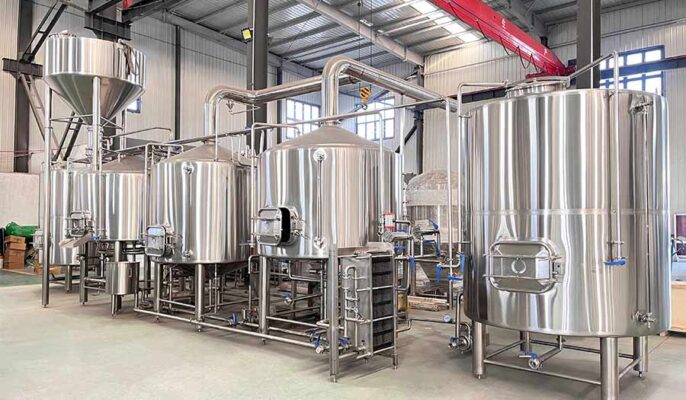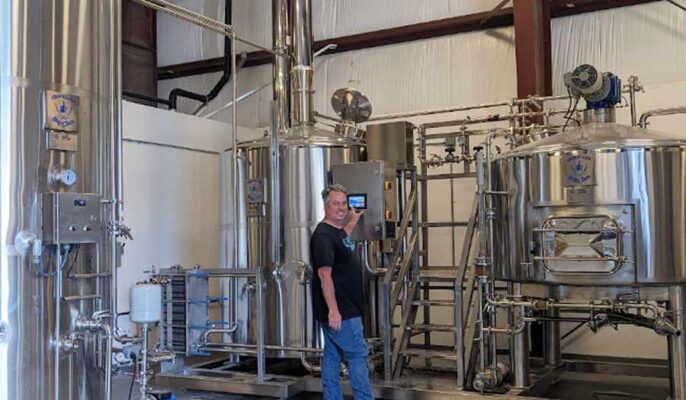Craft beer is constantly evolving and becoming an essential category in the brewing industry. As technology advances and craft breweries introduce automation systems, craft breweries are changing dramatically. The main benefit of automation is that it allows most brewery operations to “free up their hands” so that operators can take care of other things. Of course, it also reduces staffing levels. Other benefits include consistency, as automation avoids human-specific errors such as forgetfulness, differentiation, and so on. An automated craft brewery allows the brewer to better focus on the quality of the beer.
What is an automated craft brewery?
Traditionally, brewing has been a manual and often labor-intensive task, but with the advent of automation, many aspects of a craft brewery can be automated to ensure consistency, efficiency, and optimal results.
Features of an automated craft brewery:
|
FEATURE |
FUNCTION |
|
Programmable Logic |
Enables customization of the brewing process. |
|
Automatic Cleaning |
Reduces the manual labor required after brewing. |
|
Data Storage |
Allows for recalling specific brewing recipes. |
|
Precision Control |
Ensures the optimal environment for brewing. |

Basic Components of an Automated Craft Brewery System
With a growing selection of automated brewing systems on the market, MICET’s range of smart design, ease of use, and customizability will make brewing fun and efficient. You’ll love brewing with this high-quality and great-looking technology. While we love brewing beer, we understand that not everyone is eager to know every detail of the brewing process. Especially when it comes to using automated systems to produce quality beer.
制御システム
The control system is the heart of an automated craft brewery. It is responsible for monitoring, controlling, and adjusting the various parameters of the brewing process to ensure the quality of the beer and the efficiency of production.
- PLC (Programmable Logic Controller): The PLC is the core device of the control system and is responsible for executing the preset logic control program. It collects data through sensors and then controls actuators, such as valves, pumps, and temperature control systems for fermenters, according to set algorithms.
- Sensors and Measuring Devices: are used to monitor various parameters in the brewing process, such as temperature, pressure, liquid level, PH value, etc. These sensors transmit real-time data to a PLC or data acquisition system for real-time control and monitoring.
- Actuator: The actuator controls various actions in the process according to the instructions from the PLC, such as adjusting valves, starting pumps, controlling heating or cooling equipment, etc.
Data Acquisition and Monitoring System
- Real-time monitoring interface: Operators can view the data and parameters of each step in real-time through the monitoring interface to make timely adjustments and responses.
- Data Storage and Analysis: Historical data storage and analysis functions allow brewers to review and analyze past production data to optimize processes, predict trends, and improve product quality.
Automated Operating Units
- Fermenter Control System: Automated control of fermenter temperature, agitation, and pressure to ensure yeast activity and fermentation efficiency.
- Cleaning and Sanitizing System: An automated cleaning and sanitizing system enables regular cleaning procedures of pipes and equipment to ensure hygiene standards and product quality.
Recipe Management System
Recipe management systems are used to manage and adjust beer recipes to meet market demands and the diversity of consumer tastes.
Safety systems
Systems can detect potential safety risks or abnormalities and take the necessary emergency shutdown measures or issue alarms to protect equipment and personnel.
Automatic brewing system for craft breweries
モルト粉砕
For small systems, a pair of roller mills are often used. The discharge port is directly connected to the material water mixer. The start and stop buttons of the mill are used as the program start signal. The temperature and flow of the mash tank water are pre-set, and the opening of the regulating valve and the speed of the hot water pump are automatically controlled by the PLC. After mixing, the mash pump directly pumps from the bottom of the mash tank. After the grinding process is completed, the mill is turned off and the system automatically runs the CIP flushing program. Of course, for large brewery equipment, it is recommended to use a wet malt mill with grain tank weighing.
Mash tank
All steps can be pre-edited, such as preheating temperature, multi-stage temperature control parameters, stirring speed, opening and closing of steam valves during automatic operation, etc. When the temperature rises, the stirring motor and steam valve start at the same time. When keeping warm, the stirring delay stops, and the liquid level is displayed. When the sugar pumping process is about to end, the system will automatically add water to drain the remaining sugar, stop the pump valve when the material is empty, and then automatically run the CIP program.
発酵タンク
The temperature of the fermentation tank is controlled in two stages. After the wort enters the tank, you can set a separate temperature curve for each tank. After the setting is completed, click Run, and the system will automatically control the temperature and pressure according to the set value.
RAL tank
All process parameters such as tank bottom water, feeding, static, reflux, filtration, lees washing, and metering are pre-set according to the process requirements. Before the mash tank is discharged, the filter tank is ready for feeding. All paving and washing water are automatically added through the flow setting, and the flow is adjusted according to the liquid level to complete the filtration in the shortest time. During this period, the speed and height of the rake are automatically controlled by the turbidity sensor. After the filtration is completed, the pump valve is automatically closed and the grain is discharged, and then the CIP program is automatically run.
ケトル水タンク
The internal heater is used to heat the wort evenly and form strong convection. The diversion cap is configured to form an umbrella-shaped spray surface to increase the volatilization of DMS. The boiling process parameters can be pre-set, including the start and end time of boiling. The hop feeder is configured to pre-put hops and automatically add hops according to the set time. The boiling tank automatically operates according to the wort level, and the pump valve automatically stops and the CIP program runs after the material is discharged.
CIP cabinet
The cleaning of the hot water tank, hot alkali tank, acid tank, various pots and tanks, and the high-temperature sterilization of the wort pipeline are all configured by the CIP station. The mash system is equipped with a CIP distribution jumper, and each channel is controlled separately; the fermentation system is equipped with a pump and a circulation pipeline to avoid conflicts with other cleanings. All pumps, valves, temperatures, and liquid levels in the CIP station are automatically operated according to the program.
冷水タンクと氷水タンク
Real-time display and control of liquid level. The cold water tank is used to cool the fermented wort, freeze the brewing water to 4°C, and after heat exchange with the wort, it reaches 80°C and enters the hot water tank for material washing. The ice water tank is used for fermentation. The refrigerant is ethylene glycol. The temperature is usually maintained at -4°C. The ice water pump is automatically started by the program during wort cooling and fermentation cooling.

How is automation affecting craft breweries?
生産効率の向上
Automation systems have significantly increased the productivity of craft breweries. Traditionally, brewing beer is a complex process involving multiple steps and tight time controls. Automation systems allow for precise control of each step, from raw material handling to fermentation and bottling, dramatically reducing human error and production time while increasing throughput and consistency.
Automated mashing
The system automates the process of mixing water and malt, ensuring that the mixture reaches and maintains the correct temperature for the enzymes to convert starch to sugar.
Recipe Precision
Craft brewers pride themselves on their unique recipes. Automation brings a level of precision to the brewing process that ensures consistency from batch to batch. From malt milling to hop addition, automated systems follow recipes meticulously, reducing human error and increasing the ability to replicate desired flavors.
Clean and sanitary
Automated CIP systems clean and sanitize tanks, piping, and other equipment without disassembly. These systems ensure thorough cleaning, reduce downtime, and maintain sanitation standards.
Automatic Cooling
Once the boil is complete, the wort must be quickly cooled to a temperature suitable for the yeast. Automated systems often include integrated cooling mechanisms to effectively speed up this step.
発酵の制御
The role of the yeast is to consume sugar and produce alcohol. Automated systems often include temperature-controlled fermentation chambers to ensure that the yeast thrives and produces the desired alcohol content and flavor.




